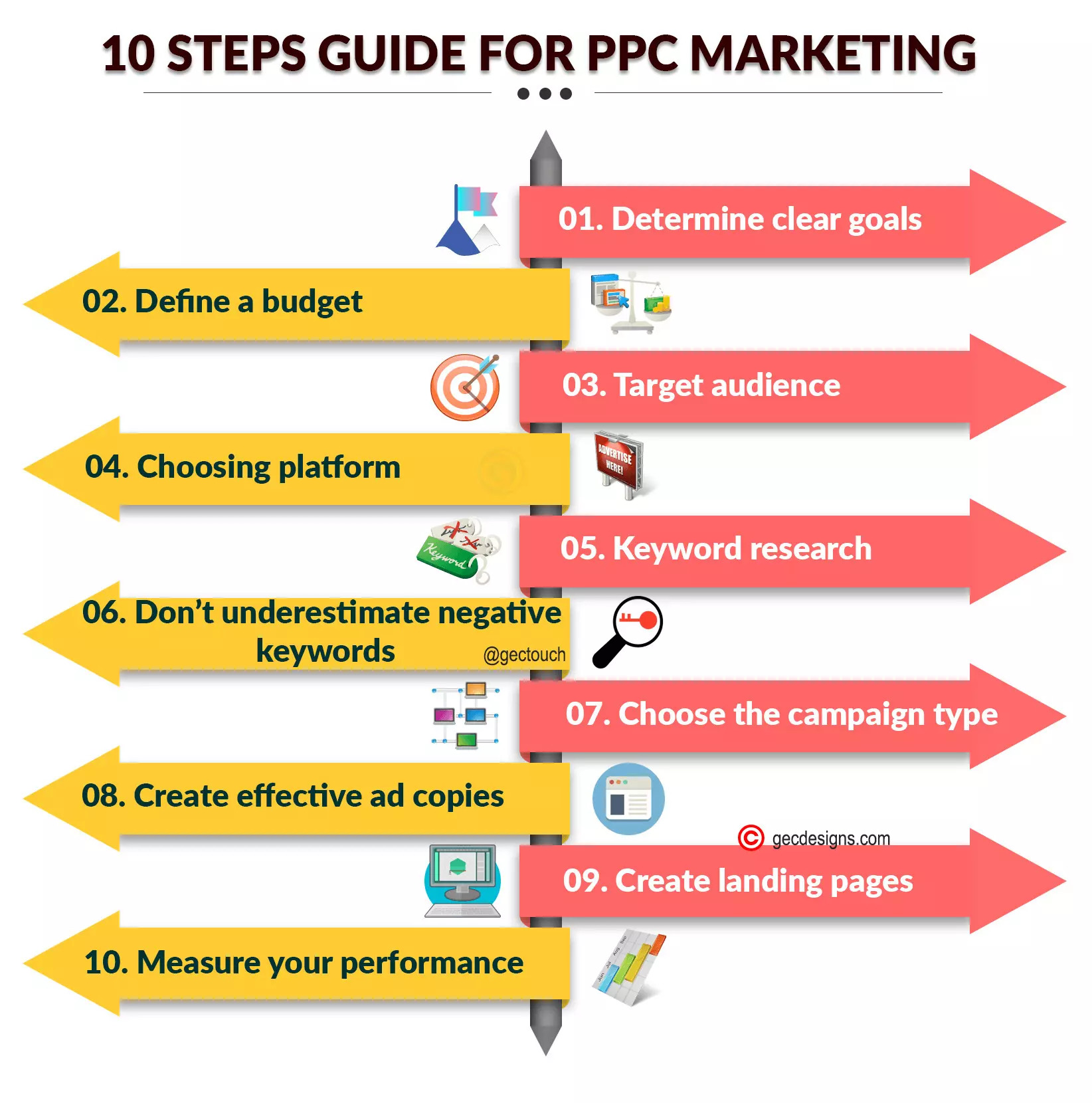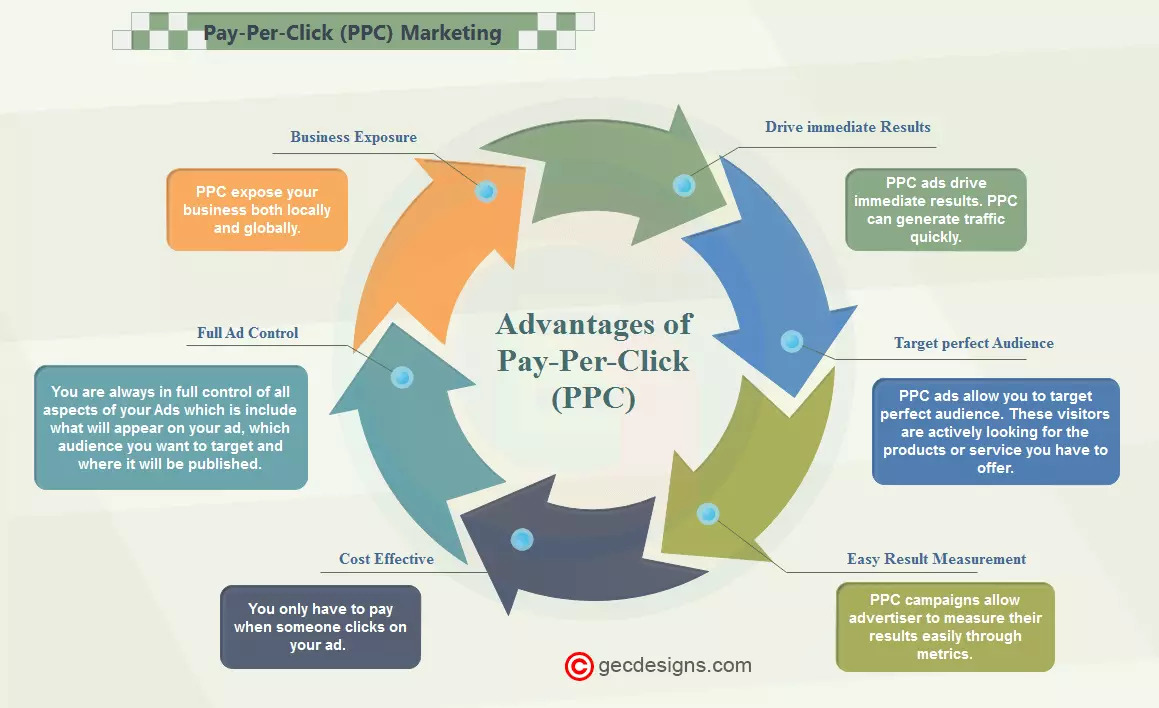What Is PPC? A 10 step guide to PPC advertising
Pay per click (PPC) is a model of internet marketing. PPC is a form of online advertising in which advertisers pay the publisher, each time a potential customer clicks their ads. Pay per click is the best tool to attract qualified visitors to your website. PPC is simply known as buying visits to your website instead of organic search. The main purpose of PPC is to increase sales and promoting brand awareness.
Search engine ads are the best example of a PPC form of advertising. In PPC advertising, advertisers can bid for ad deployments in search engine's sponsored links when people search for a particular keyword. When a user clicks on the ads, the links direct the audience to the advertiser’s website.
There are different pay per click platforms such as Google AdWords, Bing ads you can use to promote your business online.
Step by Step guide for PPC advertising
1. Determine clear goals
At first, you need to decide your online marketing goals. Before you start the campaign you should address the following questions,
- What is the purpose of the campaign?
- What is your budget?
- Is it to encourage more sales?
- Is it to increase traffic to your website?
- Is it to increase brand awareness?
- Is it for lead generation?
- Is it to promote a new product or service?
Having a clear goal is key to the PPC campaign. Identify your goal will help you to plan your Ad strategy.
PPC is simply known as buying visits to your website instead of organic search. The main purpose of PPC is to increase sales and promoting brand awareness.
2. Define a budget
After determining your goals it is time to decide your campaign budget. Before starting a PPC campaign calculating the potential ROI (return on investment) is one of the important things.
Find the answers to the following question to handle the PPC campaign challenges,
- What is your website’s current conversion rate?
- How many leads do you need through PPC?
- How long does it take for a new customer to visit your website?
- What is the average value of your new customer?
- What one click is really worth to you?
- What are the characteristics of your target lead segment?
There are some factors you need to focus on budgeting
- The geographic area which you are targeting
- Keyword selection
- CPC estimates - Increased competition for a keyword will affect your cost per click
- Click through rate
- Product nature
- Target devices - which will help you to customize your ads.
Calculating a budget using CPC
Budget = Traffic * Cost per click (CPC)
Calculating a budget using CPA
Budget = Cost per action (CPA) * conversion
3. Target audience
Understand your target audience, this will help you to create a campaign structure. Audience data can be found in many places. In Google Analytics, you can find data on User Demographics, user Location, user behavior, and so on. This will help you to find your target audience.
There are a number of ways to target your audience which includes,
- Demographics - demographic targeting helps you to reach customers who are likely to be within the demographic groups that you choose. Google determines the user information based on demographic data of Users such as gender, age, education, income level, parental status, and languages.
- Location - where you want your ads to be shown? Location targeting allows you to target your ads to appear for people in a specific location. Location targeting helps you to find the right customer. You can target locations such as country, cities, state, zip code, and territories. If you don’t want your ads shown in specific places you can also use location exclusions to exclude people located in those places.
- Ad Schedules - You can set your ads to run on a specific schedule. Ads schedule is Specify certain hours or days when you want your ads to be shown. Ad scheduling helps you to identify which time and day will provide value to your business. Scheduling can be set at a campaign level.
- Devices - This targeting can be set at the Campaign level. You can set your ads to be shown only on mobile devices, laptop computers, desktops, or tablets. Mobile app promotion ads will only show on mobile devices.
- Remarketing - Remarketing lists for search ads (RLSAs) allows you to customize your ad campaigns based on the user behavior of previous website visits. Remarketing ads are a great opportunity to reconnect with users and encourage users to come back to your website.
4. Choosing a platform
There are several platforms available where you can choose to place your ads such as Google Adwords, Bing ads, and social media channels like Facebook.
Google Adwords - This is the most popular PPC platform because Google is the most widely used search engine in the world. It gives millions of consumers to access your website who are actively searching for your product or service. Google Adwords offers the most variety of keyword matching options which will help you to target the right audience. If you are willing to pay the highest rate for biding your ads can be moved to the top positions right away.
Google Adwords allows you to show your ads in two places
- Search network
- Display network
If you want to use AdWords you need a Google account. Go to the Google Adwords page. Click the “Start Now” button to continue. Google redirects you and asks for your email and website address. Fill in that information and click the “Continue” button to proceed.
Bing Ads – Bing is owned by Microsoft. Bing ads also allow you to show your ads in the search network and display network. Bing offers product ads. Product ads allow you to display your products on a results page. Elements of product ads include images, prices, and your company name. Bing ads have less competition.
Google Adwords allows two description lines with 35 characters each and Bing ads allow only one line with a maximum of 71 characters. Both Adwords and Bing offer keyword research tool.
5. Keyword research
PPC keyword research helps you to drive targeted traffic to your website. The first step is thinking about your keywords based on your products or services. Enter those keywords into the Google Keyword Tool to create a list of related phrases. You can find hundreds of keywords that people are using. This is a great way to get core words and phrases that describe your business.
Next check your competitor’s keywords which are working for them and driving the traffic to their sites. Now start narrowing down your keywords list based on relevance. Finally, you need to create a small keyword or phrases list which is highly relevant. You need to calculate how much you can bid on your chosen keywords. Bid on long-tail keywords that have less competition and more targeted.
When choosing the keywords, you need to pay special attention to the match types you are selecting.
There are four keyword match types,
Broad match - This is the default match type. Google will match your ad against the possible queries. Ads may show on searches that include synonyms and related searches. This type will give you the widest reach but it has the least relevance.
Broad match modifier - It prevents synonym matches. You can set a Broad match modifier keyword by adding a plus sign in front of your keywords. It locks the audience by putting ‘+’. Broad match modifier helps to control your ads can appear for closely related keywords. It targets a wide audience. It can help your keywords achieve a high click-through rate.
Phrase match - For setting a Phrase match keyword you put keywords in quotes. In this match type, the ad only shows when the search query includes a full phrase. Ads won't show if words in the phrase are reordered.
Exact match - In exact match putting the keyword in brackets sets. It is the most exact match which means all the words are present in the same order without any words before and after. Ads may show on searches that match the exact term. Exact match keywords provide the lowest reach but highest relevance.
Broad match keywords allow the maximum number of impressions and clicks.
6. Don’t underestimate negative keywords
Negative keywords are the opposite of your target keywords. Negative keywords prevent your ad from being triggered by a certain word or phrase. If you add negative keywords to your PPC campaigns, your ads will not show to a user who is searching for that phrase. This is also known as a negative match and excluded keywords.
One of the most common negative keywords is “free.” Most companies do not want to target users who are looking for free products or services.
Negative keywords help you to filter out unwanted traffic. It helps to save your money. It helps to improve your ad quality scores. Quality scores help you with bidding strategies by allowing you to bid less than a competitor.
The main benefits of negative keywords are,
- Exclusion of irrelevant traffic
- Improve conversion rate
- Low Cost per Click
- Increase your ROI
- Improve overall click-through rate
- Improve quality score
7. Choose the campaign type
Before you start your campaign, you need to find out the type of campaign. There are several types of campaigns in Adwords.
- Search network campaigns
- Display network campaigns
- Shopping campaigns
- Video campaigns
Search network campaigns
This is keyword-based advertising. A search network campaign allows you to show your text ads to your target audience. Ads will show to people who are actively seeking out information based on the keywords or phrases. The main purpose of a search network campaign is to drive traffic to your website.
Display network campaigns
The display network consists of millions of websites, blogs, and articles that accept to show text ads, banner ads, and video ads. In this type, ads are shown within the site’s content. In-display network campaign you can choose where you want your ads to show up and you can target your audiences who are more likely to be interested in your products or services. This can be achieved through demographics, placement, topics, and remarketing. This campaign will help to raise your brand awareness.
Shopping campaigns
Shopping campaigns use product data, not keywords. It is also known as product listing ads. It helps you to promote your products. Shopping campaigns are typically used for e-commerce websites. It allows you to give detailed information about your product before the user even clicks your ad. The attributes include a photo of your product with the title, product category, price, brand, and more. This gives you more qualified leads.
Video campaigns
Video campaigns allow you to display your video ads on YouTube search results or within other streaming videos.
Video ad formats include,
- TrueView in-stream ads.
- TrueView video discovery ads.
- Bumper ads.
Compared to TV ads it is much cheaper.
8. Create effective ad copies
PPC is an excellent way to drive targeted traffic to your site and boost sales. Ad text is very important in your campaign. Ad copy is a term that refers to the main text of a clickable advertisement.
Writing effective ad copy is not easy because you have to craft a compelling message in a small space. It takes some time. Writing ads require technical understanding. Your Ad copy must attract your customer to visit your website.
It has three parts,
- Headline text - The headline of your ad is the first thing that people see in your ad. So consider the keywords. This will help you to reach the correct audience. Your text and consists of two headlines limited to 30 characters each.
- Display URL – It shows your website address. This will help visitors get a better sense of where they will be taken when they click your ad.
- Description - Use the description to promote your product or service. Tell the audience about your product. This is where you should include your best call to action. Limited to 80 characters.
Tips for writing your Ad copy
- Create headlines that fit everything else you wanted to say within the ad.
- Make sure that keep your keywords in the copy.
- Make sure your CTA is compelling. Use words like a book now, order online, save, best, sign up, etc.
- Include emotional triggers in your ads. Use words like Free, New, Because, Instant, and Imagine.
- Conduct competitor analysis that will help your PPC campaign
- Create a unique URL which is containing your keywords.
- Use numbers and statistics in your Ad copy. Use Numbers like dates, pricing, and percentage.
- Use punctuation properly.
- Include the benefits of product or service
- Use an Ad extension which is the key to offering additional information about your Ad copy.
- Be clear and relevant. If your Ad copy is not relevant to your visitors they are not likely to click it.
9. Create landing pages
The main purpose of the landing pages is conversion. Landing page optimization is important to increase the performance of your PPC campaign.
Tips to optimize your landing pages
- The landing page for your ad should provide clear content and that is relevant to your ad text.
- Make sure that your landing page headline explains to your visitors what the landing page is about
- Your landing page should be mobile responsive.
- Your landing page should have a clear call to action.
- Include video on your landing pages. It is an excellent way to capture your visitor's attention.
- Use relevant images.
- Use your keywords in your landing page content.
- Include trust signals such as contact information, testimonials, and reviews.
- Avoid too much content with slow loading time.
- Contrasting colors work great on buttons
- Create easy to navigate landing pages.
10. Measure your performance
After giving enough time to grow your PPC campaign, now it is the time to review your KPIs. Analyze your campaign performance is a great way to look for areas that require improvement.
There are some metrics that you should monitor
- Clicks - the number of times the user clicked on your Ad.
- Click through rate - the percentage of clicks your ad received divided by its impression. It is one of the most important factors determining your quality score. If low CTR means that your Ad and keywords need improvement.
- Quality score - it is Google’s rating of the quality. It determines the quality of your keyword, landing page and Ads. Google uses your quality score to determine your Ad Rank.
- Conversion rate - the number of times a user clicked on your ad and completed the desired action within a specific period of time.
Conversion rate = conversion / no of clicks. - Cost per conversion - total cost of conversion divided by a number of conversions. Keep track of your CPC to learn how to improve your campaign.
- Bounce rate - the number of visitors goes to your landing page but does not respond to your call to action.
Advantages of PPC Marketing
- PPC ads drive immediate results. PPC can generate traffic quickly.
- PPC ads allow you to target perfect audience. These visitors are actively looking for the products or service you have to offer.
- PPC campaigns allow the advertiser to measure their results easily through metrics.
- You only have to pay when someone clicks on your ad.
- You are always in full control of all aspects of your Ads which is include what will appear on your ad, which audience you want to target and where it will be published.
- PPC expose your business both locally and globally.
Now you know the basics of PPC, you can plan your marketing strategy. Please note, PPC advertising requires a dynamic strategy. If it is implemented properly, it can help you to achieve your goals and increase your website traffic.

Rajanarthagi
Content writer and Marketer
An enthusiastic SEO expert, passion for digital marketing with two years of expertise in writing Digital Marketing and SEO content. She is a Master of Business Administration graduate from a reputed university in south India. Her passion for SEO and online marketing helps her to stay up to date with the trends and strategies. Follow her on social media sites, to stay up to date with SEO, and Digital Marketing, Updates. To contact Raji, visit the contact page.






